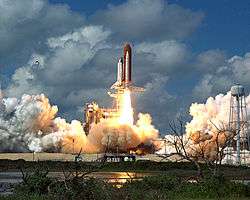1988 in spaceflight
 Space Shuttle Discovery launches on STS-26R, the first US manned spaceflight after the Challenger accident | |
| Orbital launches | |
|---|---|
| First | 6 January |
| Last | 29 December |
| Total | 121 |
| Catalogued | 116 |
| National firsts | |
| Satellite |
|
| Orbital launch |
|
| Space traveller |
|
| Rockets | |
| Maiden flights |
Ariane 4 Long March 4A Shavit |
| Retirements |
Energia Titan 34D |
| Crewed flights | |
| Orbital | 5 |
| Total travellers | 19 |
The following is an outline of 1988 in spaceflight.
Launches
| Date and time (UTC) | Rocket | Launch site | LSP | |||
|---|---|---|---|---|---|---|
| Payload (⚀ = CubeSat) |
Operator | Orbit | Function | Decay (UTC) | Outcome | |
| Remarks | ||||||
| 7 June 21:38:16 |
||||||
| Low Earth (Mir) | Mir EP-2 | 7 September 00:48:38 | Successful | |||
| Manned flight launching three cosmonauts and landing two, computer problems during deorbit nearly resulted in loss of crew, and delayed landing by one day | ||||||
| 7 July 17:38 |
||||||
| Intended: Areocentric Actual: Heliocentric |
Mars orbiter | In orbit | Spacecraft failure | |||
| stationary lander | Phobos lander | In orbit | Never deployed | |||
| Loss of communication 2 September 1988 en route to Mars | ||||||
| 12 July 17:01 |
||||||
| Areocentric | Mars orbiter | In orbit | Spacecraft failure | |||
| stationary lander | Phobos lander | In orbit | Never deployed | |||
| "hopping" lander | Phobos lander | In orbit | Never deployed | |||
| Loss of communication 27 March 1989 near Phobos | ||||||
| 29 August 04:23:11 |
||||||
| Low Earth (Mir) | Mir EP-3 | 21 December 09:57:00 | Successful | |||
| Manned flight with three cosmonauts, one remained on Mir as part of EO-3, first Afghan space traveller | ||||||
| 29 September 15:37:00 |
||||||
| NASA | Low Earth | Satellite deployment | 3 October 16:37:11 | Successful | ||
| NASA | Geosynchronous | Communications | In orbit | Operational | ||
| Manned flight with five astronauts, first US manned spaceflight after the Challenger accident in 1986, TDRS deployed using Inertial Upper Stage | ||||||
| 15 November 03:00:02 |
||||||
| Low Earth | Test flight | 06:26 | Successful | |||
| Low Earth (Buran) | Test flight | Successful | ||||
| Unmanned test, only flight of Buran and final flight of Energia | ||||||
| 26 November 14:49:34 |
||||||
| Low Earth (Mir) | Mir EO-4/EP-4 | 27 April 1989 02:57:58 | Successful | |||
| Manned flight with three cosmonauts | ||||||
| 2 December 14:30:34 |
||||||
| NASA/NRO | Low Earth | Satellite deployment | 6 December 23:30:39 | Successful | ||
| NRO/CIA | Low Earth | Radar imaging | 25 March 1997 | Successful | ||
| Manned flight with five astronauts | ||||||
Deep-space rendezvous
There were no deep-space rendezvous in 1988.
References
|
Generic references:
|
Footnotes
This article is issued from
Wikipedia.
The text is licensed under Creative Commons - Attribution - Sharealike.
Additional terms may apply for the media files.